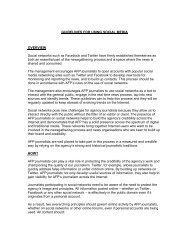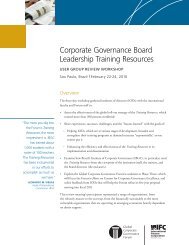SME Finance Policy Guide
SME Finance Policy Guide
SME Finance Policy Guide
Create successful ePaper yourself
Turn your PDF publications into a flip-book with our unique Google optimized e-Paper software.
G-20 <strong>SME</strong> FINANCE POLICY GUIDE<br />
31<br />
interventions that strengthen the financial information<br />
infrastructure have the potential to expand <strong>SME</strong> financial<br />
access by reducing information asymmetries<br />
between <strong>SME</strong>s and financial institutions and by facilitating<br />
the use of various lending technologies.<br />
In most LDCs, the vast majority of insolvency cases<br />
will result in the liquidation of the troubled enterprise,<br />
due in part to the relatively low value of <strong>SME</strong>s in<br />
LDCs, which in turn reduces the incentive to restructure<br />
failing businesses. The prevalence of liquidation<br />
necessitates that one of the first orders of business in<br />
LDCs is the development of clear, predictable rules<br />
and processes to be followed when a debtor cannot<br />
repay its creditors, in order to foster greater confidence<br />
amongst potential lenders. These rules should<br />
address, inter alia, the financial conditions under<br />
which an insolvency process will be started with<br />
respect to a borrower, the process for liquidating<br />
assets to repay creditors, the role that creditors play in<br />
the liquidation process and in controlling the overall<br />
insolvency process, and the order of priority for distributing<br />
proceeds.<br />
A built-in constraint to the improvement of insolvency<br />
processes in LDCs can be weak court capacity. Since<br />
insolvency cases often require urgent treatment by the<br />
courts, the ability of courts in LDCs to hear cases<br />
quickly and render decisions based on commercial<br />
analysis and predictable legal principles will serve as a<br />
hard constraint to the overall improvement of the<br />
insolvency system. As such, tackling the issue of court<br />
competency, particularly as regards the ability of judges<br />
to deal with commercial issues in a practical and timely<br />
manner, is critical. At the same time, finding ways to<br />
reduce the dependence upon courts for the resolution<br />
of insolvency cases will likely increase both recoveries<br />
by creditors and the number of distressed businesses<br />
that are able to successfully reorganize and continue as<br />
going concerns. In these regions, policy interventions<br />
that strengthen the financial information infrastructure<br />
Example: Insolvency regime (Colombia)<br />
In 1999, as Colombia was in the midst of a financial<br />
crisis and facing a backlog of failing businesses entering<br />
a very inefficient bankruptcy process, the country<br />
undertook a reform of its bankruptcy code. This law,<br />
known as Law 550, streamlined the reorganization process<br />
by establishing shorter statutory deadlines for<br />
reorganization plans, reducing opportunities for appeal<br />
by debtors, and requiring mandatory liquidation in<br />
cases of failed negotiations. The pre-reform reorganization<br />
process was so inefficient that it failed to separate<br />
economically viable firms from inefficient ones.<br />
Once it was reformed, the country’s insolvency system<br />
managed to separate viable from nonviable enterprises,<br />
allowing the former to restructure and liquidating<br />
the latter. By substantially lowering reorganization<br />
costs, the reform improved the selection of viable firms<br />
into reorganization, and increased the efficiency of the<br />
bankruptcy system.<br />
Source: Giné and Love (2006) 37<br />
have the potential to expand <strong>SME</strong> financial access by<br />
reducing information asymmetries between <strong>SME</strong>s and<br />
financial institutions and by facilitating the use of various<br />
lending technologies.<br />
C.2.3: CREDIT INFORMATION SYSTEMS<br />
Credit reporting systems help satisfy lenders’ need for<br />
accurate, credible information that reduces the risk of<br />
lending and the cost of loan losses by providing a reliable<br />
indication of whether an applicant will repay a<br />
loan. Research indicates that bank lending is higher<br />
and credit risk is lower in countries where lenders<br />
share information, regardless of the private or public<br />
nature of the information-sharing mechanism. Wellfunctioning<br />
credit reporting systems reduce adverse<br />
selection and moral hazard, and can contribute to both<br />
an expansion of credit and a reduction in lending costs<br />
by facilitating the adoption of lending technologies<br />
based on credit scoring models. The development of<br />
37 For further information, see Giné, Xavier and Love, Inessa, Do Reorganization Costs Matter for Efficiency? Evidence from a Bankruptcy<br />
Reform in Colombia (2006). World Bank <strong>Policy</strong> Research Working Paper No. 3970; available at http://siteresources.worldbank.org/DEC/<br />
Resources/Do_Reorganization_Costs_Matter_for_Efficiency-8Jul09.pdf














![Print a two-page fact sheet on this project [PDF] - IFC](https://img.yumpu.com/43449799/1/190x245/print-a-two-page-fact-sheet-on-this-project-pdf-ifc.jpg?quality=85)


